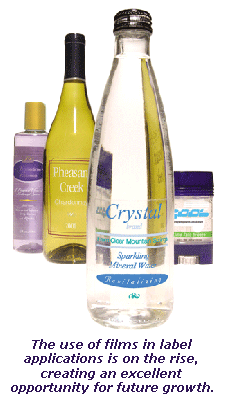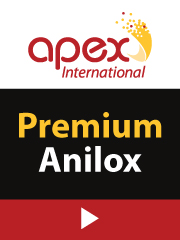Trends & Technical Solutions
- Published: December 31, 2005, By Dr. Stephen Cray, Dow Corning Corp.
Web Exclusive
Often paired with film facestocks, filmic release liners are used in many pressure-sensitive applications today, ranging from no-label look beverage labels to diaper closures, medical applications, and labels for health and beauty aid products. The market for filmic release liners is growing at a rate of 10%/yr, fueled in part by the emergence of premium applications that require the level of optical clarity, water resistance, flexibility, or fiber-free performance films can provide.
Key Trends Impacting Technology Selection
Many factors influence the selection of materials and coating technologies for filmic laminates, such as end-user requirements; converting, laminating, die-cutting, and printing requirements; adhesive and substrate characteristics; environmental concerns; locally available material choices; and silicone release coating technology.
A self-adhesive laminate is a complex structure. The facestock, adhesive, silicone release coating, and backing substrate impact and are impacted by one another. The silicone release coating plays a critical, enabling role that allows the entire release construction to function. Compatibility and robustness are key, but the silicone technology being used also can drive process decisions and other trade-offs.
Desirable End-Use Properties
Films offer a degree of surface smoothness and added value functionality, such as flexibility, water resistance, and perhaps even stain resistance that positively impact label performance and appearance.

Because of the surface smoothness of films, there is virtually no pattern transfer from the liner to the adhesive. This is essential for clear-on-clear applications where surface roughness can translate into a cloudy or hazy appearance in the end-use application. The flexibility and texture of films are benefits in applications like diaper closures. The water resistance of films makes them ideal for labeling health and beauty aid products exposed to moist environments. Also, some medical applications require the use of fiber-free materials, e.g., films.
While on the rise, the use of films in label applications is relatively low today, creating an excellent opportunity for future growth.
Cost Reduction Trends
The global p-s marketplace is driven by the need to produce increasingly more labels faster and at lower cost. Consequently, there is a growing need for release coating systems that can be applied at high line speeds and cure quickly. Low-temperature cure is desirable as well, because it reduces energy costs and supports the coating of temperature-sensitive filmic substrates.
Another cost-reduction effort that impacts material selection is the trend toward reducing substrate caliper. Lower-caliper materials cost less. However, in the case of paper, lowering caliper lowers strength and increases the potential for tearing.
Films potentially have several advantages over paper. Their surface smoothness facilitates even coverage during the coating process, and their superior hold-out reduces the amount of silicone coating required. Additionally, films are relatively incompressible and can have the required stiffness to provide sharp die-cutting. Their inherent strength, even at lower calipers, offers the potential for higher conversion speeds and better throughput while minimizing concerns about costly web breaks. To balance this, however, films must be selected carefully to withstand the conditions in the siliconizing and conversion processes.
Films are less able to withstand elevated temperature, compared with paper. This is particularly true of polyolefin films. Polyester films are somewhat more robust physically and are less difficult to handle as a web. It is advisable to measure shrinkage and tensile strength at the conversion temperature to ensure that the substrate can be processed at the required tension levels without unacceptable levels of shrinkage or permanent film stretching.
It also must be realized that the paper manufacturers are making large strides to meet the growing demands of the evolving end-user applications. For example, some grades of paper have excellent smoothness and hold-out performance and can cost effectively compete with films in some of these value-added segments.
One less direct cost-reduction strategy that is beginning to find favor today is that of involving silicone release coating and other material suppliers early in the laminate development process. By working together, suppliers often are able to help laminatemakers take advantage of material synergies that optimize the cost effectiveness and end-use performance of the entire structure.
Technology Trends
Due to environmental concerns and regulatory pressures, many release coating operations, especially in Europe and the Americas, have decreased their reliance on solvent-based coatings and moved toward solventless, emulsion-based, and UV-cure technologies.
On the adhesives side, water-based acrylics dominate the p-s label market. However, the use of hot melt and UV-cure adhesives is growing. This has important release coating implications, because the coating’s primary function is to provide the appropriate release profile against the chosen p-s adhesive.
The market is seeing changes in substrates as well. The rise in the use of polyester (PET), oriented polypropylene (OPP) and polyethylene (PE) films, both as facestocks and liners, has led to the development of UV- and low-temperature-cure release coatings designed especially to meet the needs of temperature-sensitive materials.
Substrate Properties
Filmic substrates differ considerably in their properties (see Table I). Selecting the best one for any given application often involves making trade-offs. Polyester can offer the best across-the-board performance but often requires priming to achieve good release coating anchorage, which increases its cost. However, recent advances in silicone release coating technology now enable coating of less-costly unprimed polyester films.
| Table I | |||||
| A Comparison of Filmic Substrate Properties and Applications | |||||
|---|---|---|---|---|---|
| Ease of Thermal Cure | Initial Silicone Rub-Off | Delayed Rub-Off | Caliper Control | Cost | |
| Treated PET | ‡ ‡ ‡ | ‡ ‡ ‡ | ‡ ‡ ‡ | ‡ ‡ ‡ | ‡ |
| Untreated PET | ‡ ‡ ‡ | ‡ ‡ ‡ | ‡ | ‡ ‡ ‡ | ‡ |
| LDPE | ‡ | ‡ ‡ ‡ | ‡ ‡ | ‡ | ‡ |
| HDPE | ‡ | ‡ ‡ ‡ | ‡ ‡ | ‡ | ‡ |
| BOPP | ‡ | ‡ ‡ ‡ | ‡ | ‡ ‡ | ‡ ‡ |
| MOPP | ‡ ‡ | ‡ ‡ | ‡ | ‡ ‡ | ‡ ‡ |
| ‡ Difficult ‡ Fair ‡ ‡ Good ‡ ‡ ‡ Very Good | |||||
For polyolefin liners, thermal cure, particularly with low-density PE, is challenging, although rub-off issues tend to be less severe compared with general-purpose grade PET.
PP can have quite different properties depending on the method of manufacture. Biaxially oriented PP films can compete with PET in liner applications. Thermal cure and delayed rub-off can be quite challenging, and the silicone system must be selected carefully to get the desired balance of properties. Metallized OPP generally can withstand higher cure temperatures than BOPP.
Table II shows the p-s applications where PE, PET, and OPP films are most frequently used today and where their use is expected to grow in the future.
| Table 2 | |||||
| Pressure-sensitive applications for filmic substrates today and tomorrow | |||||
|---|---|---|---|---|---|
| Applications | PE | PET | OPP | ||
| Labelstock | ✓ | ✓ ✓ | ✓ | ||
| Graphic Arts | ✓ | ||||
| Tapes | ✓ ✓ | ✓ | ✓ | ||
| Hygiene | ✓ ✓ ✓ | ✓ | |||
| Building | ✓ ✓ ✓ | ✓ | ✓ | ||
| Covering Films | ✓ | ||||
| Decorative Vinyl | |||||
| Healthcare and Medical | ✓ | ✓ | ✓ | ||
| Large application today | Large application tomorrow | ||||
Coating Technologies
There are two basic ways to cure silicone release coatings onto films: via heat (thermally) or via UV or e-beam radiation. Thermally curable coatings employ either solvent-based or solventless (100% silicone solids) delivery systems. Solventless systems may be based on either vinyl or hexenyl polymers. Solvents frequently are added to solventless coatings to improve spreading and as an aid in processing.
Table III compares the performance of solvent-based, UV-curable, and today’s new solventless release coating technologies for films.
| Table III | |||
| A Comparison of Current Release Coating Technologies for Films | |||
|---|---|---|---|
| Properties | Solvent | UV | New Solventless Technologies |
| Cure Speed | Slow | Very fast | Medium-Fast |
| Cure Temperature | >85°C (185°F) | Ambient | >90°C (194°F) |
| Achorage | Excellent | Good | Good |
| Coat Weight (lb/ream) | 0.4 | 0.8-1.3 | 0.8-1.3 |
| Range of Release | Broad | Limited | Broad |
| Release Stability | Excellent | Moderate | Excellent |
| Environment | Poor | Excellent | Excellent |
| Material Cost | Low-Medium | Very High | Medium |
Solvent-Based Coatings—Solvent-based coatings offer the advantages of low coat weight, good anchorage to films, very good wetting, and optical clarity. However, they cure more slowly than solventless coatings and have a more limiting health, safety, and environmental profile.
UV-Curable Solventless Coatings—UV-curable solventless release coatings can be used on a broad range of thermally sensitive substrates. They have excellent bath life, low misting potential, and cure quickly. The capital investment in curing equipment for a dedicated UV line is significantly less than for a thermal line. However, raw material costs are high. Catalyst inhibition can be a problem on clay-coated papers and nitrogen inerting may be required. More importantly, only a limited range of release profiles can be created. Additionally, UV-curable coatings may become unstable against hot melt adhesives and some aggressive acrylics.
Thermally Curable Solventless Coatings—Thermally curable solventless release coatings are compatible with a broad range of adhesive types. They offer a wide range of stable release forces and can be applied using conventional coating equipment. Although not suitable for very heat-sensitive substrates, some of today’s new thermally curable technologies can be cured at temperatures as low as 90°C (194°F). Coat weights are limited to current solventless coating techniques (gravure).
Process Considerations
Process considerations that affect the outcome of siliconizing films with thermally curable coatings include these options:
- Web tension control—Good web tension control is essential when using thin calipers of some substrates.
- Temperature control—Some films are more temperature-sensitive than others, LDPE in particular.
- Coat weight—Reducing coat weight can reduce costs, but reducing it too much can negatively impact coverage and consequently release performance. Filmic substrates generally offer the lowest coat weight potential.
- Film variability—Different additives, such as antioxidant, antifungal and anti-blocking agents, can affect anchorage and inhibit cure.
- Process conditions—Corona versus non-corona.
- Catalyst—Tin catalysts are less prone than platinum catalysts to catalyst inhibition.
Key Challenges for Coating Films
Key challenges for coating unprimed polyester are primarily anchorage related. However, it is possible to achieve no rub-off immediately after coating and excellent anchorage after six months of aging at ambient temperature and 50% or above relative humidity by taking one of the following steps:
- Changing process conditions (e.g., using corona treatment).
- Using anchorage additives.
- Or adopting one of the new silicone coatings designed especially for thermally curing on films; these innovative coatings have unique architectures that improve anchorage performance even on unprimed polyester.
Key challenges for coating PP or PE are related to the temperature sensitivity of these substrates and the need for low-temperature cure.
Improvements in low-temperature cure performance can be achieved by making the following changes:
- Increasing the concentration of platinum catalyst in the release coating formulation.
- Increasing the SiH:Vi ratio [the ratio of the methylhydrogen functional siloxane crosslinker and vinylfunctionalsiloxane polymer used in the crosslinking reaction].
- Using more reactive polymers and crosslinkers.
- Selecting filmic substrates that are non-inhibiting.
- Changing process conditions—corona versus non-corona.
The use of filmic release liners is growing, fueled by high-value no-label look applications. In addition to their ability to deliver optical clarity, films possess beneficial properties, such as strength, hold-out and surface smoothness that are likely to increase market interest and consequently application growth.
Different films present different challenges, including anchorage, low-temperature cure requirements, and the need for release modification. However, major technology breakthroughs occurring in thermal solventless release coatings are making it easier to overcome those challenges.
UV-curable and especially the new low-temperature-cure solventless silicone systems designed especially for films are likely to out-strip solvent-based systems as the preferred vehicles for siliconizing film.
SUPPLIER INFO:
Dow Corning Corp.—dowcorning.com

Dr. Stephen Cray has been with Dow Corning for more than 20 years. In 1998 he joined Dow Corning’s Paper Industry Group where he currently works on the development of thermal solventless silicone materials for filmic release liner applications and low-cost release coating systems. He earned his doctorate in synthetic organic chemistry at Sussex Univ. in the UK.












